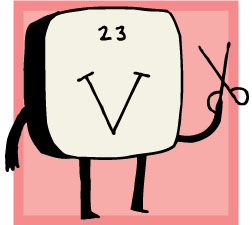Blogging the Periodic Table

Yesterday's post looked at selenium, an element that causes serious health problems if you ingest too little and if you ingest too much. The point was that the body needs its elements in specific doses.
Sometimes, as in the case of today's element, vanadium, that dose is zero—the body doesn't need it even in trace amounts. But neither is it a straightforward toxin, something the body will immediately reject. Its effects are more subtle and bizarre.
For starters, vanadium makes an excellent spermicide. Most spermicides work by dissolving the fatty membrane that surrounds sperm cells, spilling their cellular guts all over. Unfortunately, all cells have fatty membranes, so spermicides often attack the lining of the vagina as well, irritating the cells there and making women susceptible to yeast infections. Vanadium avoids this collateral damage by going after something unique about sperm cells—their tails. For an unknown reason, when vanadium enters sperm cells, it zips right over to the molecular motor that makes the tails wriggle and sabotages it. The tails then snap off, leaving the cells immobile, unable to swim their way forward to find the female egg.
At least that's how vanadium works in lab tests. No one yet knows if Element 23 can make the transition into a safe, tolerable product for humans. Indeed, one reason vanadium hasn't appeared on the prophylactic market is that it has other biological effects, especially in the blood. Creatures like sea squirts and sea cucumbers have evolved to use vanadium in their blood cells instead of iron, a substitution that can turn their blood green. (Vanadium can also turn the tongues of humans green.)
Scientists also have evidence that vanadium can raise and lower the level of sugars like glucose in our blood. Once again, no one knows why this happens—the effect is mysterious and sporadic. That hasn't stopped people from leaping to the conclusion that vanadium could cure blood-sugar disorders. And so, despite the mild toxicity of the element, you can find vanadium-laced water for sale as a "cure" for diabetes. Some places even offer premium diabetes water from the vanadium-rich springs of Mount Fuji, as if being bottled on the highest mountain in Japan gives the water extra powers. (There is no evidence such cures work.)
It's one thing to prey on people with an element like zinc—which doesn't cure the common cold (sorry) but which, when it fails, does little harm. But to sell gullible people vanadium for diabetes (or selenium for AIDS), sometimes in lieu of standard treatments—that's pretty low. Unfortunately, it's also an inescapable part of the sometimes sordid history of the periodic table. Almost every element has been hailed as a miracle cure for something at some point, and you can find pills or supplements of many elements still today.
Like Slate on Facebook. Follow us on Twitter.